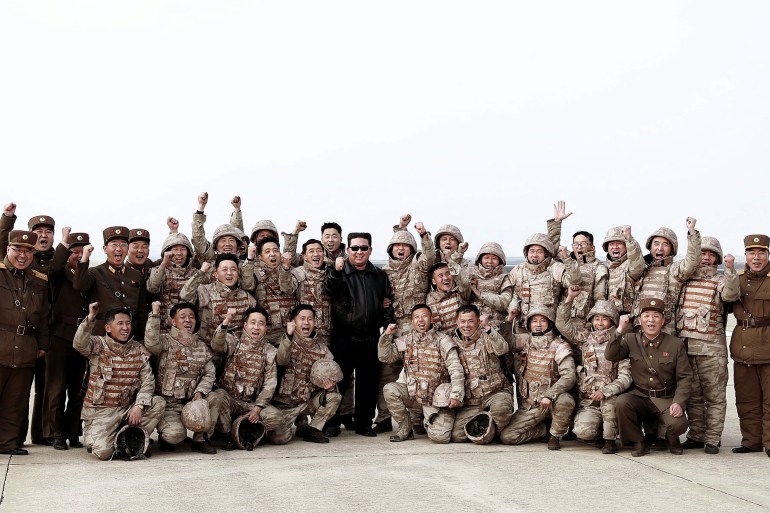Kim Jong Un pledges to build up North Korea’s attack capability
North Korean leader says his country will develop more ‘powerful strike means’, days after the launch of long-range Hwasong-17 ICBM.

Kim Jong Un, pictured at the launch of the Hwasong-17, says he plans to improve his country's attack capabilities [KCNA via KNS /AFP]
Published On 28 Mar 202228 Mar 2022
North Korea’s leader Kim Jong Un says his country plans to develop more powerful means of attack, days after its first intercontinental ballistic missile (ICBM) launch since 2017.
The statement published by the official Korean Central News Agency (KCNA) on Monday suggests North Korea might soon perform additional launches or even test a nuclear device as it pushes to modernise its military arsenal.
On Thursday, the country conducted its 12th round of
weapons tests this year, launching the newly developed, long-range
Hwasong-17, which analysts say is potentially able to deliver a nuclear warhead anywhere in the United States.
During a photo session with scientists and others involved in the Hwasong-17 test, Kim expressed a resolve to build up the country’s attack capability to cope with any threats, according to KCNA.
“Only when one is equipped with the formidable striking capabilities, overwhelming military power that cannot be stopped by anyone, one can prevent a war, guarantee the security of the country and contain and put under control all threats and blackmails by the imperialists,” KCNA quoted Kim as saying.
Kim said North Korea will develop more “powerful strike means” and that he expected his country to “more vigorously perfect the nuclear war deterrence of the country”, KCNA said.
Pyongyang said the Hwasong-17 flew to a maximum altitude of 6,248km (3,880 miles) and travelled 1,090km (680 miles) during a 67-minute flight before landing in waters between the Korean Peninsula and Japan.
Outside experts said if the missile were fired on a standard trajectory, flatter than the steep test angle, it could fly as far as 15,000km (9,320 miles), enough to reach anywhere in the US mainland and beyond.
Believed to be about 25m (82 feet) long, the Hwasong-17 is the North’s longest-range weapon and, by some estimates, the
world’s biggest road-mobile ballistic missile system. Its size suggests the missile is meant to carry multiple nuclear warheads, given the North already has single-warhead ICBMs that could also hit most of the US.
US-led diplomacy aimed at convincing North Korea to denuclearise in return for economic and political benefits largely has stalled since 2019. The Biden administration has urged Pyongyang to return to talks without any conditions, but Pyongyang has responded Washington must first drop its “hostility” and has taken steps to expand his weapons arsenals.
Some experts say Kim could soon conduct a further ICBM launch, a launch of a satellite-carrying rocket or a test of a nuclear device as he works to perfect his weapons technology, and increase the pressure on the US.
On Monday, South Korea reiterated a previous assessment that there are signs that North Korea is restoring previously demolished tunnels at its underground nuclear testing site. Lee Jong-joo, a spokesperson at Seoul’s Unification Ministry, said that a nuclear test by North Korea would pose “a serious threat” to international security and that the North must halt any related acts immediately and return to talks.
The Hwasong-17 lift-off was North Korea’s most serious weapons launch since it tested a previously developed
ICBM in November 2017. Its last nuclear test, its sixth overall, was in September 2017.
Source
 Kim Jong Un, pictured at the launch of the Hwasong-17, says he plans to improve his country's attack capabilities [KCNA via KNS /AFP]
Kim Jong Un, pictured at the launch of the Hwasong-17, says he plans to improve his country's attack capabilities [KCNA via KNS /AFP]



Comments
Post a Comment